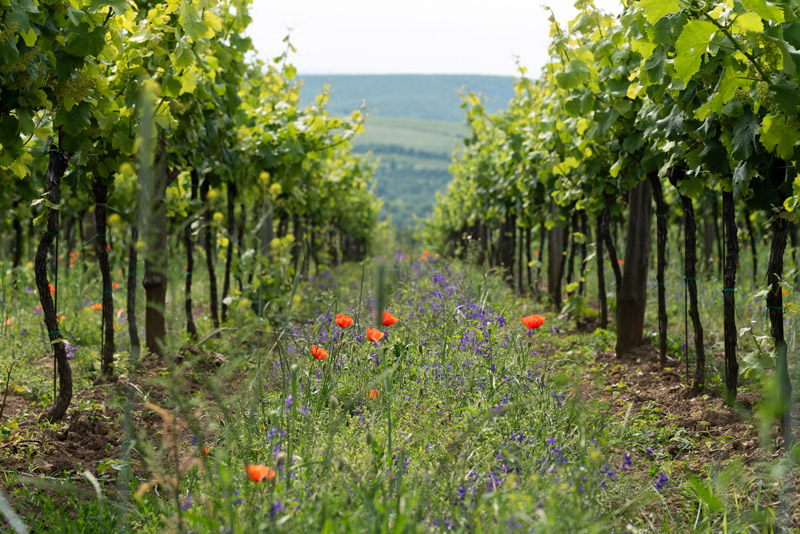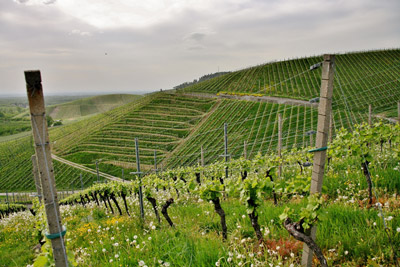-
Canopy Management
- » DF Pneumatic Leaf Remover
- » C-305 Independent Hydraulic Power Unit
- » CM-FF – Orchard Topper
- » CM-SF – Synchronized Bar Mower Topper
- » CM-SD – Synchronized Double Topping Machine
- » CM-SDT – Simple Synchronized Double Topping Machine
- » CM-SNU – Over-the-Row Topping Machine
- » CM-SNE – Electric and Hybrid Synchronized Topping Machine
- » CM-B – Basic Topping Machine
- » CM-SN New Model Synchronized Topping Machine
- » CM-S Synchronized Topping Machine
Grass-growing in the vineyard: the choice of the plant species as a strategy to climate change

Lcontrolled grass planting of the vineyard is a practice sustainable agricultural becoming more and more popular time to the improvement of the quality of the soil, to water conservation and promotion of biodiversity.
This technique consists inthe introduction is the deliberate plant species in a row or between rows of vines, with the aim to optimize the interactions between the plant, soil, and plant species themselves.
The article aims to explore the dynamics and benefits of cover crops are controlled and of cover crops in rows every other row, highlighting the importance of the selection of plant species according to the specific objectives and the context of climate, with an eye to climate change.
Grass-growing in the vineyard: a practical agricultural success in
Thecontrolled grass planting of the vineyard implies theintroduction of vegetation cover between the rows of vines, chosen strategically to bring specific benefits to the vineyard.
This practice can improve the structure of soil, increase biodiversity, reduce soil erosionand evapotranspiration , and improve the water balance of the soil.
In addition, it can help to adjust the vigor of the vines improving indirectly the quality of the grapes.
In recent years, the practice of cover crops has been adopted with increasing interest from growers all over the world, recognizing the benefits in terms of sustainability and improving the quality of wine production.
In Europe, and in particular in Italy, theadoption of this practice has seen a significant growth, reflecting a shift to farming methods that respect the dellenvironment andlocal ecosystem.
According to some estimates, in Italy, the number of farmers who adopt lgrass-growing in their vineyards exceeded 40% in recent years, the signal of a wide acceptance of this practice among manufacturers aware of the importance of a more sustainable approach to agriculture.
The success and spread ofgrass as agricultural practice are in part due to the flexibility and variety of the techniques are applicable to, and can be adapted to the specific needs of each vineyard, and to the local environmental conditions.
This includes the possibility to choose between grass total or in rows every other row, as well as the selection of plant species specific the better you adapt to the climate, soil, and goals of the production of the vineyard.
The ability to customize thegrass means that every grower can find the most suitable strategy to improve the sustainability and theefficiency of his own vineyard, making this practice a key component in the modern management of wine-growing.
Grass vineyard rows every other day
Thegrass in rows every other row is a variation of the technique of grass that is in the’alternate file is weed free and file work in the vineyard.
This method allows you to maintain a balance between the benefits of cover crops and the need to limit the competition for water and nutrition for the screws.
The rows-processed may be used for agricultural operations, while the rows of vines, planted to make the benefits already described in terms of the improvement of the soil and biodiversity.
(You may be interested in: “inter-row: control and grass weed“)
Choice of species for the controlled grass planting of the vineyards
The choice of the species for thecontrolled grass planting of the vineyards it is a crucial process that requires a deep understanding of the interactions between the vegetation, the soil and the vines.

Source: Image wirestock on Freepik
, The diversity of species chosen for the grass can vary greatly depending on the specific needs of each vineyard, and of the local conditions.
Depends on many factors, including the goals of the cover crop (e.g., erosion control, nitrogen fixation, weed control) and the climatic conditions.
For example, in areas subject to water stress, you may privilege species resistant to drought to minimize competition for water with the screws.
On the contrary, in areas with abundant rainfall, the choice may fall on the species capable of absorb effectively the excess water, thus reducing the risk of water stagnation and fungal diseases.
In addition, the decision on the species to be used for thecover crops must take into account the possible interactions with the local crops and wildlife, in addition to the production goals of the vineyard, as the quality ofthe grapes and the long-term sustainability of the dellecosystem wine.
Lcover crops are controlled , therefore, represents a complex strategy, which requires a careful selection and informed of the plant species, adapted to the specificity of each environment of cultivation.
Species such as legumes, grasses , and vegetables are commonly used for their various benefits, such as the ability to fix the atmospheric nitrogen, the resistance to drought and biomass production.
Examples of plant species to climatic zones,
the mediterranean Climates (e.g. Southern Europe, some areas of California)
In areas characterized by warm, dry summers and mild winters as the Mediterranean basin or in some areas of California, species such as white clover (Trifolium repens) and ryegrass, perennial (Lolium perenne) are often chosen for the grass.
These species are appreciated for their resistance to drought, and the ability to fix nitrogen in the soil, thus improving the fertility without the need for fertilization chemistry.
Continental climates (e.g. Central Europe, parts ofArgentina)
In continental climates, with hot summers and cold winters, species such as fescue (Festuca arundinacea), and the centipede (Agrostis stolonifera) are well suited due to their resistance to cold and the ability to form a turf dense, which protects the soil from erosion and contributes to the biodiversity.
Cool climates and humid (e.g. Northern Europe, New Zealand)
In areas with cooler weather and rainy weather, such as northern Europe or New Zealand, species such as red clover (Trifolium pratense) and vetch (Vicia spp.) they are particularly suitable.
These pulses will not only enrich the soil with nitrogen, but they also support biodiversity underground and above the ground, and promoting the presence of beneficial insects and other organisms that contribute to the natural control of pests.
(You may be interested in: “Plant a vineyard: when the quality of the grapes is a matter of space”)
Some of the tools for the choice of species cover
Cover Crop Finder
The “Cover Crop Finder” is a tool developed by a team of australian researchers that facilitates the selection of cover crops adapted to specific environments and management objectives.
This tool allows farmers to identify the species that are most appropriate for their vineyard, considering factors such as climate, soil type and water needs.
The European project DRIVE LIFE
The drought hydrological affects severely in Europe, the three main wine-producing countries: Italy, France and Spain, with effects on the quantity and quality of the wine product, exacerbating the water emergency in the ecosystem of the vineyard.
The project “Drive Life” (Drought Resilience Improvement in the Vineyard Ecosystem – “Improving the resilience of water in the vineyard”) (Catholic University of the Sacred Heart), co-funded by the european Commission in the framework of the LIFE Programme 2014-2020 aims to identify and propose solutions aimed at improving the resilience of the dellecosystem of the vineyard, while at the same time a high level of competitiveness of the product, as well as reducing thewater footprint and the need for irrigation.
Among the solutions to counteract the effects due to the drought of the soil are proposed sustainable management practices, including the’grass artificial under the vines.
This project emphasizes the importance of selecting plant species that can contribute to the resilience of the vineyard, optimizing the use of water and improving soil conditions.
Conclusions
Thecontrolled grass planting andcover crops in rows every other row represent the fundamental strategies for a viticulture more sustainable and resilient.
Through the careful selection of plant species taking into account the specific needs of the vineyard and of the climatic conditions, it is possible to significantly improve the health of the soil, the management ofwater and biodiversity.
These practices not only contribute to a greater quality ofgrapes and wine, but they also promote an ecosystem wine more balanced and resistant to environmental stress.
Ladoption of innovative tools such as Cover Crop Finder” and the participation in research projects such as “DRIVE LIFE” underline lcommitment to the agricultural community and the scientific to the practical cultivation of more informed and sustainable.
These tools, and projects that provide farmers with the knowledge and resources required to address the challenges posed by climate change and to improve the long-term sustainability of their vineyards.
In summary, thegrass of the vineyards, when carefully planned and managed, can provide many environmental and economic benefits.
Encouraging biological diversity, improves the structure and fertility of the soil and optimizing luse ofwater, lgrass is a key to the future wine, more resilient and productive.
The responsible choice, and targeted species cover, supported by tools of decision advanced and the sharing of knowledge at the community level, it is essential to maximize these benefits and ensure the prosperity of the viticulture in a world of change.
(You may be interested in: “Chopping vineyard: flail mower and a good ally for the fertilization of the land”)
(you May be interested in: “Machines interceppo: weed control, mechanical inter-row in the vineyard or orchard”)
Sources / Readings of interest
below, some of the references that might be of interest to deepen the topic ofcontrolled grass planting of the vineyards.
Cover crops in viticulture. A systematic review: Implications on soil characteristics and biodiversity in the vineyard. Javier Abad, Iranzu Hermoso de Mendoza, Diana Marín, Luis Orcaray, Luis Gonzaga Santesteban. Vol. 55 No. 1 (2021): OENO One. Publication date: 15 March 2021. https://doi.org/10.20870/oeno-one.2021.55.1.3599
This work is an attempt to summarize the knowledge on theuse of cover crops in vineyards over the last 20 years, highlighting the one hand the characteristics of the soil such as nutrition, organic carbon, the structure or theerosion and, fromthe other, environmental factors such as soil and biodiversity in the vineyards and gas emissions.
Cover crops competition for water in vineyards: case studies in the mediterranean terroirs.Carlos M. LOPES. LEAF, Instituto Superior de Agronomia, Universidade de Lisboa. The article presented toXI International Terroir Congress, July 2016, McMinnville, Oregon (USA). https://www.repository.utl.pt/handle/10400.5/13127
In this article are presented the data on the use of the water and on the performance of the lives obtained in the three experiments of soil management (tillage vs. turf area inter-row), conducted in three different wine regions of Portugal and the mediterranean, which covers the vineyards are not irrigated and irrigated), will be presented.
The discussion focuses on the competition for water part of the sods and the corresponding effects on the force of the screw, on the yield and composition of the berries.
Cover Crop for a Sustainable Viticulture: Effects on Soil Properties and Table Grape Production.Concetta Eliana Gattullo, Giuseppe Christmas Mezzapesa, Anna Maria Stellacci, Giuseppe Ferrara, Giuliana Occhiogrosso, Joseph Petrelli, Mirko Castellini and Matteo Spagnuolo. Agronomy 2020, 10(9), 1334. Date of publication: September 5, 2020. https://www.mdpi.com/2073-4395/10/9/1334
The purpose of this study was to evaluate the effect of a cover crop of fescue (Festuca arundinacea Schreb.) on the quality of the soil on the yield and on the quality parameters of grapes in a vineyard to table grapes, cv (“Italy”) located in the south of Italy, by comparing the results with the conventional machining.
A native plant species cover crop positively impacted vineyard water dynamics, soil health, and vine vigor.Margaret Fernando, Natalie Scott, Anil Shrestha, Suduan Gao, Lauren Hale. Date of publication: 11 March 2024. https://www.sciencedirect.com/science/article/abs/pii/S0167880924000902?via%3Dihub
The study was conducted to determine the impacts of cover crops on the dynamics ofsoil water, on the health of the soil and on the growth of the crops during the creation of a vineyard of grapes Autumn King in a mediterranean climate semi-arid, in particular in the Central Valley of California.
Phacelia (Phacelia tanacetifolia), a plant species native of the region, and a species introduced, rye (secale cereale L. Merced), were planted as cover crops during the cool season in the inter-row of screws and compared with a standard management practice spaces, inter-row without cover crops.
Impact of cover crops in the vineyard on the aroma compounds of Vitis vinifera L. cv Cabernet Sauvignon wine.Zhu-mei, Yong-sheng, Li Zhang, Hua Li. sciencedirect.com. Date of publication: 13 January 2011. https://www.sciencedirect.com/science/article/abs/pii/S0308814611000999
This study compared the influence of different cover crops with clean processing on the aromatics of the wine vines Cabernet Sauvignon of 5 years. In the vineyard have been used, white clover, alfalfa, and festuca arundinacea and compared with a clean processing.

